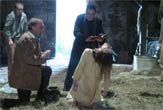Voice of Reason: Exorcisms, Fictional and Fatal

A new film about exorcism is set to be released on September 9. The Exorcism of Emily Rose, starring Laura Linney and Campbell Scott, is about a priest accused of negligence resulting in the death of a nineteen-year-old woman during an exorcism. While demons, devils, and exorcisms are obviously great grist for horror films, The Exorcism of Emily Rose is interesting because it shows (however fictionally) the potentially dangerous consequences of exorcisms.
As the film opens across the country, a Romanian priest stands accused of just such a crime in real-life. An exorcism at a convent in the small Romanian town of Tanacu resulted in the death of Maricica Irina Cornici, a twenty-three-year-old nun who said she heard the devil telling her she was sinful. With assistance from four nuns, priest Daniel Corogeanu bound Cornici to a cross, gagged her mouth with a towel, and left her for three days without food or water. The ritual, the priest explained, was an effort to drive devils out of the woman. Cornici was found dead on June 15; an autopsy found she had died of suffocation and dehydration. Cornici, who had a history of schizophrenia, reportedly had recently visited the convent and soon after joined the order. The Orthodox Church admitted that Corogeanu had been ordained as a priest without completing his theological studies, and condemned Cornici's death.
While many Americans likely think of exorcisms as relics of the Dark Ages, exorcisms continue to be performed, often on people who are emotionally and mentally disturbed. Whether those undergoing the exorcism are truly possessed by spirits or demons is another matter entirely. Most often, exorcisms are done on people of strong religious faith. To the extent that exorcisms "work," it is primarily due to the power of suggestion and the placebo effect. If you believe you are possessed, and that a given ritual will cleanse you, then it just might. (For more on exorcisms, see Joe Nickell's Investigative Files column in the January/February 2001 issue of Skeptical Inquirer magazine.)
A 2001 book on the topic, Michael Cuneo's American Exorcism: Expelling Demons in the Land of Plenty found no reason to think that anything supernatural occurs during exorcisms. After attending fifty exorcisms, Cuneo is unequivocal about the fact that he saw nothing supernatural--and certainly nothing remotely resembling the events depicted in the 1974 blockbuster film The Exorcist. No spinning heads, levitation, or poltergeists were seen, though many involved some cursing, spitting, or vomiting. As far as science is concerned, possession is a mental health issue.
Maricica Cornici is not the first innocent victim of an exorcism. On August 22, 2003, an autistic eight-year-old boy in Milwaukee was bound in sheets and held down by church members during a prayer service held to exorcise the evil spirits they blamed for his condition. An autopsy found extensive bruising on the back of the child's neck and concluded that he died of asphyxiation. In the past ten years, there have been at least four other exorcism-related deaths in the United States alone, two of the victims children. Then there are several tragic cases like that of Texas mother Andrea Yates, who drowned three of her children in an effort to exorcise the devil from herself in 2001. More recently, a South African couple was arrested for keeping their fifteen-month-old daughter caged, unfed, and tied up because they believed the child was possessed.
Exorcisms in film and fiction can be entertaining, while exorcisms in real life can be fatal. The tragic irony is that in many cases the evil is committed not by the Devil, but by those who believe in him.
Benjamin Radford is an investigative writer and film critic. His article on the true story behind The Exorcist can be found at http://www.radfordreviews.com.
Sign up for the Live Science daily newsletter now
Get the world’s most fascinating discoveries delivered straight to your inbox.



